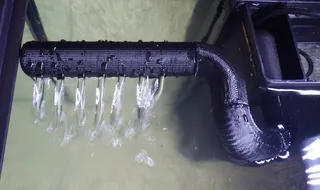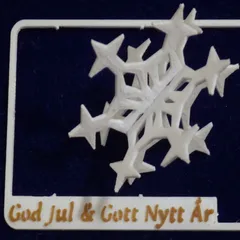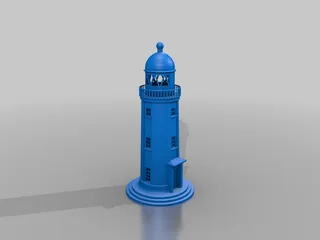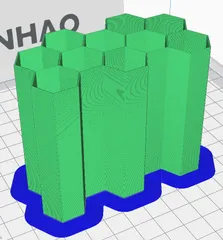Laser guide for Atomstack A5 Pro (and other similar laser cutters)
Description
PDFThis is a mount for a 12 mm diameter crosshair laser pointer module on the housing of the laser of a laser cutter/engraver.
Print Settings
Printer Brand:
Anycubic
Printer:
Kobra 2
Rafts:
No
Supports:
No
Resolution:
0.2 mm
Infill:
10%
Filament: ClasOhlson PLA orange Notes:
no supports necessary, print with the flat side down
How I Designed This
Step 1: Design process
I have a new tool - a 40 cm x 40 cm diode laser cutter/engraver, an Atomstack A5 Pro. Like for many other laser cutters in its price class it comes as a quite bare bone device without enclosure and without any guide.
In LaserGRBL the blue laser diode itself can be switched on as a pilot point to adjust the position of the workpiece or trace out the size of the engraving pattern. In LightBurn I have not found this option yet, but I much more liked the idea of mounting a cross-beam laser pointer on the outside of the laser housing.
I was inspired by Steve Makes Everything's video Take Your Diode Laser to the Next Level: Add a Crosshair for Precision but I wanted something better:
- to make a more sturdy mount, so I planned to 3D print a mount
- and to power it from the laser cutter itself, not from a clumsy 3 V battery.
The main laser housing of many laser cutters is based around the dimensions of a 40 mm x 40 mm cooling fan for the laser module itself. In the case of the Atomstack A5 PRO the top of the laser housing is an isolating plate of clear acrylic roughly protecting the driver electronics for the laser diode underneath. I set out to design a 3D-printed part which would replace the top acrylic plate and side mount a laser pointer module.
Cross-hair laser pointer modules can be cheaply found on Amazon and Aliexpress
- https://www.amazon.com/s?k=laser+crosshair
- https://www.aliexpress.com/w/wholesale-laser-crosshair.html
the design here is for a 12 mm diameter cartridge.
I checked the pinout of the 3-pin JST-XH connector on the laser head: pin 1 is +12 V, pin 2 is GND and pin 3 is the pwm signal for the laser diode power modulation.
I also checked the current consumption of my red cross-hair laser diode module, which was about 34 mA at 3 V operating voltage. Now I had essentially two options:
- a regulator to bring down the 12 V to 3 V for the red laser diode or
- just limiting the current by a series-drop resistor.
I decided for the simpler option and just used a 270 Ω series resistor to drop 9 V at 34 mA. The power loss in the resistor is 300 mW so a 0.6 W metal film resistor is good enough to reliably do the job.
I just smashed together a veroboard for the connection. The 2.50 mm spacing of the JST connectors fits good enough onto the 2.54 mm spacing of the veroboard. But if you wanted you could of course create a small printed circuit board...
Step 2: Usage
As nicely described in the video linked above, LightBurn allows to enter an offset between a guide laser and the cutting laser in theDevice Settings dialog. It then uses the cross-hair position for alignment of the starting point (when in relative positioning mode) and for drawing the outlineFrame of your design. For the engraving/cutting process it then automatically shifts the laser head by the given offset.
But how do you determine the offset? You need a scrap work piece.
At the very first focus the cutting laser onto the work piece and focus the cross-hair onto the work piece. The focusing of the cross-hair laser at the same time rotates the cross-hair, so that you have to both rotate the body of the laser pointer module, shift it up and down and rotate the front ring. Once in focus lock the laser into place with the locking screw.
draw a square in Lightburn with the lower left corner at the (0,0) position and choose lower-left as the job origin
make a pencil cross at the current position of the red laser cross on the work piece
engrave the square into your work piece
measure the horizontal and vertical distance between the engraved square and your pencil markings - these are the offset values which you have to enter into LightBurn
check your settings, by re-engraving the same square, but now with the offset activated. The square should now line up with the starting point and after finishing the laser cross should neatly line up with the lower left corner of the engraved square.
You might need to fine-tune the settings a bit, it took me three steps to get it accurate.
Category: Machine ToolsTags
Model origin
The author marked this model as their own original creation. Imported from Thingiverse.




